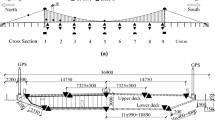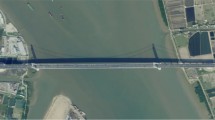Abstract
The aim of this paper is the study of the effect of temperature variation on the structural response. In particular, the behavior of a railway bridge located in the south part of Austria is investigated using health monitoring system. Among the large amount of data collected the influence of the temperature variation of the structural response is analyzed.
Access provided by Autonomous University of Puebla. Download chapter PDF
Similar content being viewed by others
Keywords
- Fiber Bragg Grating
- Structural Health Monitoring
- Thermal Inertia
- Fiber Bragg Grating Sensor
- Bragg Wavelength
These keywords were added by machine and not by the authors. This process is experimental and the keywords may be updated as the learning algorithm improves.
1 Introduction
The process of detecting, localizing, classifying, and providing a prognosis for damage (i.e. change in material and/or geometric properties, boundary conditions and so on) to engineered structures is referred to as Structural Health Monitoring-SHM. This process often involves the observation of a system over time using periodically sampled dynamic response measurements from an array of sensors, the extraction of damage-sensitive features from these measurements, and analysis methods to determine the current state of system health. SHM can be used for rapid condition screening and aims to provide, in near real time, reliable information regarding the integrity of the structure. However, in applying such an approach, one must properly account for temperature effects, which might appear as or conceal damage [1–3]. This paper is dedicated to this topic and uses a case study on the ÖBB Brücke Großhaslau railway bridge to elaborate its discussion.
The SHM system installed on the bridge consists of Fiber Bragg Grating (FBG) sensors. The sensors FBG are particular spectrum sensors. The peculiarity of these sensors is the ability to modify the local value of the refractive index of the fiber’s “core”, using in an appropriate way a laser light. In other words, the device behaves as a filter in optical transmission and as selective reflector of the wavelength λ in reflection, as depicted in Fig. 1.
The final consequence due to the passage of a broadband bundle of light along the fiber, is that the photo-etched grating, reflects a specific wavelength called the Bragg Wavelength λ B described by the following equation:
where n eff is the refraction index, and Λ the mark distance.
The ability of the FBG to select a specific signal from a broadband light spectrum is the ground for the data transmission as shown in Fig. 2. In this way, the various FBG sensors filter and reflect back specific frequencies within the frequency package which constitute the signal. In order to understand this, one can make the analogy that the set of frequencies are similar to the set of conversations that are running on a telephone line and the FBG are appropriate selectors that extract a specific conversation (a specific frequency in our case) by sending it to the recipient where a suitable opto-electrical transducer translates the optical signal into an electrical signal for the final treatment up to our phone [4, 5]. A generic composition of a monitoring system that uses FBG sensors is shown in Fig. 3 and summarized as follows:
-
Optical fiber with the FBG sensors;
-
Fiber-optic cable connection between the sensors and the control electronics (max 10 km length);
-
Control electronics: the electrical core of the system;
-
A PC connected to the control electronics via a local cable, network, Internet or GSM modem, where data are stored and potentially analyzed.
The structure analyzed in this study is a railway bridge called ÖBB Brücke Großhaslau located in the south part of Austria (see Fig. 4), built between 2009 and 2010, which is on the railway ÖBB Martinsberg – Schwarzenau and crosses the road Zwettler Straße – B36. It is a single span, reinforced concrete T-beam bridge that is straight and supports dual-lane rail traffic. The dimension of span is about 30 m length and 8 m width. The bottom of the span is about 6. 7 m from the street below (see Fig. 5).
Just before bridge commissioning in the Spring of 2010, some problems on the structure were detected as a result of visual inspection. This inspection revealed cracks on the central support of the deck (see Fig. 6). They concluded that these problems were related to two principal aspects:
-
Unstable supports;
-
Soil-structure interaction.
Worsening of the damaged condition was mitigated through the use of elastomeric supports under the deck as shown in Fig. 7.
However, due to the damage, the bridge owner in cooperation with Safibra s.r.o., a structural health monitoring company, decided to employ a bridge monitoring system to perform continuous monitoring to check in near real time the health of the structure, and at the same time to create a way to increase the degree of safety for the bridge’s users. The monitoring system implemented is represented in the following picture (see Fig. 8). Two different kinds of sensors were employed. The first to detect the variation of displacement (see Fig. 9) and the second to detect the variation of temperature. In total, 10 displacement sensors and 4 temperature sensors were used. The sensors are located closer to the support where the cracks appeared. The labels and the positions of the sensors are represented in Fig. 10. Data are registered once per second, stored in a datalogger, and are then sent to a PC situated in an Operation Center where they are also uploaded in a Web page: enabled users can check or downloaded them from a FTP server.
In this study, four sensor pairs (displacement and temperature) are used and are the ones indicated as circled in Fig. 10. To conduct the analysis, data from June to November 2011 are used. For the data displacements, it is noted that relative displacement between two nodes 1 m far each from the other in the original configuration are recorded. The measurement of temperature is expressed in Celsius degrees. All the data are managed by MATLab and Microsoft Excel software. For both displacements and temperature, data representations are provided for seasonal trend; monthly trend and global trend (3D) [6–8]. An example is shown in Fig. 11. For the quantification of the temperature effect for each event (represented by a train crossing) the investigated data are train crossing time, frequency of the first spectrum peak, peak value, and temperature at the time of train crossing. These data can be obtained from periodograms as the one shown in Fig. 12. From these graphs we observed that the event doesn’t influence the frequency variation, but the temperature is the main factor responsible for the variations (see Fig. 13).
After this analysis, a numerical (finite element) model of the bridge was developed using SAP2000 software. Shell elements were used to define the mesh. In calibrating the numerical model, attention is focused on the node vertical displacements, rather than on other response parameters. As such, a model very “light” from the computational point of view was obtained. After defining the geometry of the deck, in order to represent the behavior of the bearing system and the bridge abutments, vertical and horizontal springs were used to fix the nodes of the mesh. For soil-structure interaction (ground behavior) Winkler’s theory (k W = 6 kg/cm3) was adopted. Regarding the behavior of the bearing device, a vertical stiffness of the springs of 8, 000, 000 kN/m was used whereas for a horizontal stiffness a value of 800, 000 kN/m was used. This order of magnitude difference was used to represent the greater possibility of the elastomer to deform it-self under shearing loads. A schematic representation of the model is shown in Fig. 14.
The model was calibrated using a particular set of displacements and temperature data, measured in field, and extracted on July, 7th 2011. Plotting the data output related to the vertical displacement of node 20 (corresponding to the sensor s833-1-4) the plot is initially consistent, but delayed with regard to the real behavior measured by the sensor. This fact was related to the thermal inertia of the concrete. In order to compensate for this problem, and to take into account the thermal inertia of the material in a simple way, the temperature action was delayed by 4 h. In this way, the results of the model matched with the real behavior (see Fig. 15). In order to test the goodness of the numerical model it applied to another data set covering June 3rd and 4th. Once again the temperature action was delayed by 4 h. The output result was very good as shown in Fig. 16.
2 Conclusions
In this work, the effect of the temperature variation in the behavior of the Austrian ÖBB Brücke Großhaslau bridge has been studied. As a first step, data collected by the sensors located along the bridge were analyzed in order to quantify how and how much temperature could be related to the structural behavior of the bridge. Next, a numerical model was built using the SAP2000 software. A deliberate decision was taken to construct a simple model that targeted the behavior of interest in order to limit the computational operations. After calibration, the goodness of the model was tested using different sets of data from various sensor measurements. The “output” data were of good quality with respect to both computational time and accuracy (vertical displacement of the controls nodes). By analyzing the output data, it was also possible to understand, quantify, and account for the role of thermal inertia in the structural behavior. After this calibration, it was concluded that the model could be considered good for the prediction of the bridge’s behavior under thermal load. As a next development for this study, if would be interesting to take into account other environmental parameters such as the humidity.
References
Peeters, B., De Roeck, G.: One-year monitoring of the Z24-bridge: environmental effects versus damage events. Earthq. Eng. Struct. Dyn. 30(2), 149–171 (2001)
Kullaa, J.: Eliminating environmental or operational influences in structural health monitoring using the missing data analysis. J. Intell. Mater. Syst. Struct. 20(11), 1381–1390 (2009)
Kullaa, J.: Distinguishing between sensor fault, structural damage, and environmental or operational effects in structural health monitoring. Mech. Syst. Signal Process. 25(8), 2976–2989 (2011)
Inaudi, D., Vurpillot, S.: Monitoring of concrete bridges with long-gage fiber optic sensors. J. Intell. Mater. Syst. Struct. 10, 280–292 (1999)
Glisic, B., Inaudi, D.: Fiber Optic Method for Structural Health Monitoring. Wiley, Chichester (2007)
Moro, B.: Sistema Di Monitoraggio Per il Ponte ÖBB Brücke Großhaslau: effetti della temperatura. Master degree thesis, University of Pavia (2012)
Orlandoni, M.: Simulazione Numerica Dell’effetto Della Temperatura Sul Ponte ÖBB Brücke Großhaslau: effetti della temperatura, Master Degree Thesis, University of Pavia (2012)
Acknowledgements
The authors are grateful to the Czech company Safibra for making them the data available. The first author was supported by a research grant from the University of Pavia (FAR 2011).
Author information
Authors and Affiliations
Corresponding author
Editor information
Editors and Affiliations
Rights and permissions
Copyright information
© 2014 Springer-Verlag Wien
About this chapter
Cite this chapter
Faravelli, L., Bortoluzzi, D., Messervey, T.B., Sasek, L. (2014). Temperature Effects on the Response of the Bridge “ÖBB Brücke Großhaslau”. In: Belyaev, A., Irschik, H., Krommer, M. (eds) Mechanics and Model-Based Control of Advanced Engineering Systems. Springer, Vienna. https://doi.org/10.1007/978-3-7091-1571-8_10
Download citation
DOI: https://doi.org/10.1007/978-3-7091-1571-8_10
Published:
Publisher Name: Springer, Vienna
Print ISBN: 978-3-7091-1570-1
Online ISBN: 978-3-7091-1571-8
eBook Packages: EngineeringEngineering (R0)




















